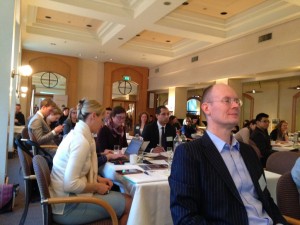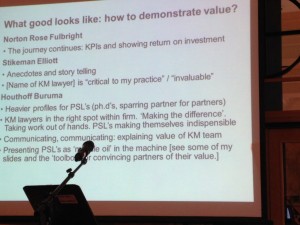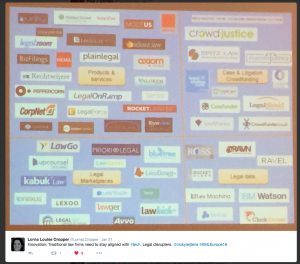 A year on from the Breakfast Breakout Martin White and I ran for Legal Knowledge & Information Management professionals in London I found myself back among them in Amsterdam at KM Legal Europe.
A year on from the Breakfast Breakout Martin White and I ran for Legal Knowledge & Information Management professionals in London I found myself back among them in Amsterdam at KM Legal Europe.
My brief was to provide a stimulating opening to the conference (I went with In at the Deep End – an Icebreaker I used at KMUK) and then give a presentation on the second day on Working Virtually. I was delighted with the enthusiastic response and the level of interaction that occured over the two days expertly led by Chairman Raffael Büchi.

So what did I see and hear (and learn), and where is Legal KM a year on?
Who or What’s driving KM in the Legal Sector?
Firstly, clients are becoming more sophisticated and insisting law firms are better. And new offshore firms are emerging that are making legal advice more a commodity product that can be disintermediated through technology. That’s having a knock on effect as firms bow to pressure for greater transparency, more efficient processes and better use of technology.
Some firms have also recognised the risk arising from the potential loss of knowledge when people and teams leave or the need to do more effective due diligence on the knowledge they are acquiring when people and teams join.
They are responding by ‘offshoring’, adopting established process improvement methodologies such as Lean/Six Sigma and integrating that into continuous proces improvement, combining CRM with EDRM, building Legal Project Management capability, attempting to get into their client’s shoes and using horizon scanning to take a look at the future.
From a Quality & Standards perspective, ISO 9001 certified firms and their Quality Managers are also casting a watchful eye on the emergent standards having noted the introduction of the amended regulations in September 2015 which for the first time made mention of Knowledge Management (Clause 7.1.6. Knowledge) noting: “The concept of organizational knowledge introduced to ensure the organization acquires and maintains the necessary knowledge”
The early KM adopters on dsplay in Amsterdam had visionary leadership to thank for embarking on their initiative, their challenge is sustainability when their sponsor departs.
These categories I find useful as a way of identifying the drivers behind a KM initiative:
- Innovation / Process Efficiency
- Risk Management
- Quality & Standards
- Vision
What trends did I see?
The ‘big’ trends for me were:
- Rise of Continuous Process Improvment initiatives supported by Process Mapping and Automated Document Assembly,
- Increasing use of Predictive Analytics “law has talked billable hours for ever. Clients using Artifical intelligenceI to cross check time sheets and identify duplicate effort”
- A recognition that billable time can be apportioned to KM related activites. I noted, “big change happens when lawyers can charge billable hours while working on KM. some tried contributor of the month rewards.”
What surprised me?
The number of partners who are known as Knowledge Partners which illustrates a career path now for Legal KM’ers.
We use Social Media to recruit but not to collaborate. In a good open discussion it was clear that the majority were sceptical about using Social Tools citing confidentiality. I was drawn to this comment from Erik Hunter who in his opening to Day Two encouraged the audience to: “think about the science of social media, the thoughts behind it, not just as push tools for comms & sales.”
Offshoring – where is my knowledge? Few of the people I spoke to had considered or made attempts to mitigate the risk of knowledge loss from outsourcing operational activitives.
The idea of a “call outs for know how” by the KM team. A tailored process based on deal flow. Looking for nuggets from across the firm.
The establishment of a Corporate University in a legal firm who have a competency framework that includes a metric of min 50 hours per year commitment to KM.
Continuous Process Improvement supported by Enterprise Search that can look across Matters Directories.
Despite recognising the importance of good project management training for the changing world the training was described as being too generic.
Use of the Knowledge Assets phrase in a couple of presentations.
Quotes that stuck (or got retweeted)
“KM means bringing the brain of the organization to the client” Paul Corney
“The value of a flexible and evolving strategy cannot be underestimated.” Andrea Alliston
“Active collaboration leads to better communication leads to more innovation.”Contract Express
“To get collaboration right you need to have good community management and know what your knowledge is” “Don’t let the collaborative tool lead the effort” and “Good stories drive good collaboration habits.” Andrew Pope

“what good looks like: demonstrating value” (of KM)
What advice would I give Legal KM’ers?
- “Fix something for someone quickly.” A great quote from a panel session to which I’d add, focus on a maximum of 3 issues, adopt a pilot approach and show results in first 6 months.
- Embrace the ‘Barbarians at the Gate‘: Legal KM’ers are getting their accreditation as Green or Black Belts. KM’ers have the facilitation skills needed to get lawyers to do process mapping and need to learn the language and practices of Lean / Continuous Process Improvement supported by Enterprise Search or change the dialogue at the senior level so that KM interventions are embedded into process. I noted: “continuous improvement can reinvigorate KM importance of process maps and fishbone diagrams” from a session by Arjan Krans.
- You need to be seen as a contributor to the delivery of the service to the client: During one of the sessions looking at turnover this statement was made: “Knowledge teams tend to be stable in Law firms” prompting this question ‘Why?” The reply: ‘A KM role is lifestyle decision with predictable time”. The point was made that Legal KM’ers are less inclined to do the unsocial hours associated with Lawyers. In plenary I made the point that in all organisations those who are seen as ‘support’ or ‘operational’ rarely get the recognition rain makers do.
- Become skilled at facilitating virtual meetings and collaboration. Communities (inwards and outwards) will continue to grow in importance. Firms are not spending enough equipping people with the social skills to make virtual encounters work effectively.
- Get in front of the client. A quote that really struck home. A lawyer was asked if he had run the proposed Application past the prospective client base. His response: “No I have a clear ideal of what they want.”
- ‘Get the squeaky wheels on side’. Have a One Pager (preferably with a visual) that summarises what you do (and don’t) do.
- “We (legal) use scattergun approach to sharing knowledge. Use social media or die!” Nicky Leijtens
And finally:
I heard this from the two legal counsels pleading for a change in the way the client / firm dynamic works: “collaborate not push, it starts to rain newsletters all of which are the same”.”Clients don’t want exclusive portals with law firms. Don’t think me & my client, think in terms of communities”
Law firms need to ensure the knowledge circulated and shared w/ clients differentiates, distinguishes & sets them apart.
I left with this, a slide captured by Lorna Louisa Cropper: “Innovation: Traditional law firms need to stay aligned with #tech.”

